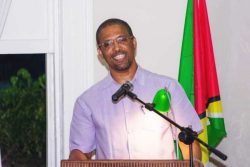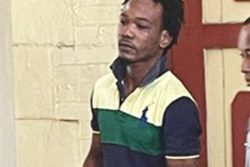“There was no negligence or abandonment of duty,” Joint Services attorney Selwyn Pieters said during his final submissions yesterday to the Commission of Inquiry (CoI) into the March 3 prison unrest and deaths.
Pieters yesterday presented oral and written submissions on behalf of the Guyana Prison Service (GPS), bringing to an end the CoI’s public hearings. The Commission has until May 31 to submit the report of its findings to President David Granger.
In Pieters’ 97-page written submission, he stated, “In any event, the main issue is clear: was the conduct of the staff of the Guyana Prison Service who was on duty on the morning of the 3rd of March, 2016 and thereafter was in compliance with the Standard Operating Procedures of the Guyana Prisons Service? The answer, it is respectfully submitted, is a clear: YES.”
Having established that the fatal events on March 3 were triggered by the removal of an inmate during an evacuation exercise, Pieters posed to the Commission that there may be a question of why a detailed operations plan had not been prepared before the evacuation of the Capital A division or why the Tactical Services Unit (TSU) and Guyana Fire Service (GFS) were not brought in on standby.
To this, he stated that it was the Director of Prisons Carl Graham, who determined the urgency of the situation, and made the judgement call that no other joint services units were needed at the time. Graham, he said, who had intended to evacuate the division, assess damage caused during the protests the night before, and replace the damaged mattresses (among other things), could not have foreseen the events that were to follow.
“It is respectfully submitted that the determinations of the Commission of Inquiry should be resolved on the basis of facts, not speculation or innuendo. The Guyana Prison Service intends to deal with the facts. On the basis of the facts, the Guyana Prison Service submits that it was compliant with policies and procedures and all that was humanly necessary was done to ensure the safety of the inmates at the New Capital Block ‘A’ Division,” the document further states.
According to Pieters, the Standard Operating Procedures kicked in from the moment Samuels began shouting “fire!” He stated further that while it was confirmed that the GFS was called, it was up to the Commission to determine whether the call was made at the sighting of the first fire or the second major fire in the Capital A division.
Citing employment law, he said the officers have the right to work in a safe environment, but he noted that while the officers, prison and fire service alike, tried to diffuse the situation, they were poked at with improvised weapons and had substances thrown at them.
In response to questions of why they had not gone into the Capital B division during their rescue efforts, knowing there was an alternate exit, he referenced the testimony of Kevin Pilgrim, Officer in Charge of the prison, who described the adjoining division at the time as a “fatal funnel.” He stated further that the officers were not equipped with breathing apparatus or any protective gear, and opined that the prison service would have come under severe criticism had they sent the officers on “a suicide mission.”
Pieters noted the limitations that exist within the prison environment that would have impacted the performance of the officers during the events of the period March 2 through 4, including inadequate staff to inmate ratio, rising number of gangs in the prison, prison location, inadequate facilities and overcrowding.
He concluded that the inmates who lit the fires and were involved in assaulting officers as they attempted to execute their duties “significantly played a role in their deaths.”
Witness credibility
Pieters questioned the credibility of the witness testimonies of a number of inmates who claimed to have never seen a range of contraband within the division, including lighters, cellphones improvised weapons, and marijuana. He stated that it was proved in evidence by prison officers and other prisoners, who admitted to having seen such, as well as in photos posted by inmates on their Facebook pages using their prohibited cellphones. He reasoned that if those prisoners could lie about something so small, how could the remainder of their testimony be trusted?
He also attacked claims made by prisoners who said they saw Samuels in the prison yard leading the task force before the fire started, and issuing an order to close the door and let the inmates burn. He offered that if Samuels had indeed given that directive, a line would have been crossed, stating that the door was locked by another officer after the order was passed by another rank, when the prisoners began rushing the door to the division.
Recommendations
“The Marriott was more important than building a brick prison,” Pieters stated in his recommendations, while pointing out that construction of a new prison block began way before the Marriott yet is still underway long after the hotel has been completed.
The recommendations stated further that the wooden buildings are a “fire hazard and a death trap” and should be either demolished or taken out of operational use, and a new prison be constructed to standard specifications. Pieters described the buildings yesterday as “historical relics” but not places to house prisoners.
Given the high rate of prison sentences over the 50-year mark, he recommended that provisions be made for an aging prison population, including the placement of geriatric wards and nurses. A call for more resources in general was also made, including fire resistant clothing, equipment and human resources. Pieters had stated earlier that the officers had been ill equipped to deal with the fire because they did not have the adequate gear. He further noted that in his testimony, Graham had stated that provisions were made for the replacement of the fire pump and for the procurement of that and other firefighting equipment, which were listed in the budget.
Other suggestions to the Commission were for more attractive salaries and allowances for the prison officers, and that the report issued by the last Board of Inquiry established after the 2002 jailbreak be revisited to consider the recommendations that were not implemented, and assess whether those recommendations could have prevented the events on March 3.
The testimonies of more than 40 individuals, including Chancellor of the Judiciary (ag) Carl Singh, the government pathologist, inmates, ex-inmates, fire officials, prison officials, police officials, a former prison official, chief medical officer, chief probation officer and chairman of parole board were all heard by the Commission.
Absent from yesterday’s proceedings were submissions from Eusi Anderson, who represented the Guyana Police Force and Guyana Fire Service, and the submissions of those attorneys who had appeared in the interest of deceased and injured prisoners and in the interest of the public.









